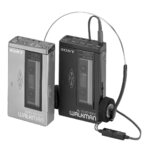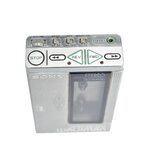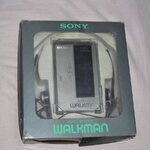 WM-7R2-D2
WM-7R2-D2

WML ID #5
- Manufacturer
- Sony
- Model
- WM-7
- Nick
- R2-D2
- Gang
- Pioneers
- Year
- 1982
- Made in
- Japan
- Initial price
- 36000 ¥Today 493 $
Technical details, specifications
- Battery
- 2AA
- Battery life
- 5h (with 2)
- Dimensions
- 79.6*134*31.1 mm (332 cm³)3D size
- Weight
- 410 gr
- Window
- yes
- Frame
- metal
- Case
- metal
- Carry
- case
- Expandable
- no
- External compartment
- no
- Head
- Bi-azimuth adjustable
- Tape selector
- Manual switch
- Waterproof
- no
- Speaker
- no
- Frequency range
- 40-15000@1,@2,@4 Hz
- FMax output
- 2x25 mW
Functions
- DC in
- yes
- Record by input
- no
- Record by int mic
- no
- Hotline mode
- no
- Cue
- no
- Balance (L/R)
- no
- Phone type
- 1
- Equalizer
- no
- Auto reverse
- yes
- Anti rolling
- no
- Logic control
- yes
- Hold lock
- yes
- Bass
- no
- Noise reduction
- Dolby B NR
- Radio
- no
- Remote control
- yes
- Wireless headphone
- no
- Indicator
- led
Description
The first ever Walkman to have auto reverse and (basic) inline remote control unit. It is one of the most complex of all the Walkman models, and the only one model ever to be released with 3 motors. Only one motor is used for tape transport though.
The introduction of the WM-7 brought several new features to the Walkman range. It was the first with full electronic (logic) controls, auto-reverse, Dolby B noise reduction and a "hold" function that blocked all the keys when set.
Except the tape transport motor, from the WM-2, the mechanical sections were all new. The brightly polished metal mechanism was highly complex yet sturdy. Two sub miniature DC motors operated the clutches and the head bridge, making remote control of the reverse and stop functions possible. Other refinements included magnetic take-up clutches and a bi-azimuth system: alignment of head separately for each direction of tape travel. The mechanism was interlocked with the door catch so that all modes were released if the door was opened. The auto reverse action was triggered electronically by an optical sensor and could be switched to play the cassette once only or continuously.
To allow the casing to be as compact as possible, just 2 AA sized batteries were used, enough for the motor but not enough for the Dolby circuit. The designers used a DC-DC converter to step up the voltage, as with the TC-D5. The converter was bulky, so it was placed in a space next to the battery holder.
Operation was simple. Providing the safety switch was not set to "hold", pressing either of the two play keys would start the tape in the direction desired. Two LED indicators showed both the tape direction and the battery condition. Winding in either direction could be initiated instantly without damage as all movements were synchronised electronically. As well as having Dolby NR, the WM-7 also had a switch that allowed chrome and metal tapes to be played back correctly.
The remote control was a "first" for a personal stereo. It worked using a special pair of headphones which contained a control unit in line with the cable. The stop and reverse functions could be triggered from this device. The system operated by open-circuiting either the left or the right headphone connection, and because of this the WM-7 could not be used with some amplifier or loudspeaker systems without a special adaptor. As a result, inserting or removing a regular 3.5mm jack will stop any operation.
The WM-7 introduced some new and interesting features, at the cost of massive complexity. It’s amazing how soon many of these features became available on lower cost, mid range models.Via Walkman Central (edited)
Documents
- Sony-WM-7-Service-Manual.pdf3065 KB

















No comments yet